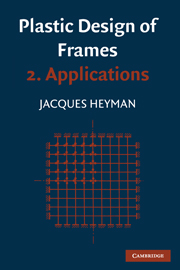8 - NUMERICAL ANALYSIS
Published online by Cambridge University Press: 05 November 2011
Summary
This chapter discusses some of the ways in which the ideas of simple plastic theory can be adapted for machine calculation. In most cases programs are already in existence, but the aim of the present discussion is not to give a catalogue of available programs, but to show how the problems of alternative loading systems, for example, or of minimum weight could be set up for numerical solution.
The ideas of dynamic programming were presented in the last chapter in relation to beam systems. Dynamic programming avoids many of the complications of non-linear programming, but the method can in fact operate with strongly non-linear cost functions. It was also mentioned that, since the method is essentially one of search over a given field, any a priori reduction of the field will lead to economies in computation time. That is, the more constraints that are introduced into a specific problem the faster the calculations. Toakley has discussed such problems of ‘discrete’ programming, including the use of Monte Carlo techniques of random search to find optimum designs.
However, the main discussion here is confined to calculations based on the assumption that a continuous range of sections is available, and will be concerned only with the use of prismatic members between the joints of a frame.
- Type
- Chapter
- Information
- Plastic Design of Frames , pp. 221 - 241Publisher: Cambridge University PressPrint publication year: 1971



